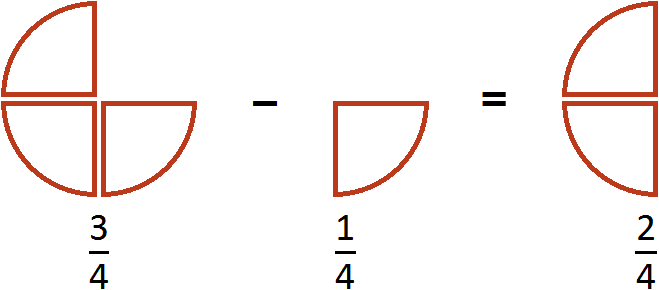First, we will learn how to subtract fractions with common denominators.
To subtract another fraction from one fraction, subtract the numerator of the first fraction from the numerator of the second fraction and leave the denominator unchanged.
For example, let's find the value of the expression  . To solve this example, subtract the numerator of the first fraction from the numerator of the second fraction and leave the denominator unchanged. Let's do that:
. To solve this example, subtract the numerator of the first fraction from the numerator of the second fraction and leave the denominator unchanged. Let's do that:

This example can be easily understood if you think of a pizza that is divided into four parts. If you cut off ![]() of the pizza from
of the pizza from ![]() of the pizza, you get
of the pizza, you get ![]() of the pizza:
of the pizza:

Example 2. Find the value of the expression  .
.
Again, we subtract the numerator of the second fraction from the numerator of the first fraction and leave the denominator unchanged:

This example can be easily understood if you think of a pizza that is divided into three parts. If you cut off ![]() of the pizza from
of the pizza from ![]() of the pizza, you get
of the pizza, you get ![]() of the pizza:
of the pizza:

Example 3. Find the value of the expression 
This example is solved in the same way as the previous ones. From the numerator of the first fraction subtract the numerators of the other fractions:

The answer is an incorrect fraction. Let's separate the integer part of the fraction:

As you can see, there is nothing complicated about subtracting fractions with equal denominators. It is enough to understand the following rules:
- To subtract another fraction from one fraction, subtract the numerator of the second fraction from the numerator of the first fraction and leave the denominator unchanged;
- If the answer is an improper fraction, you need to select the integer part of it.
2. If you find an error or inaccuracy, please describe it.
3. Positive feedback is welcome.